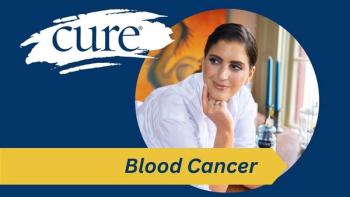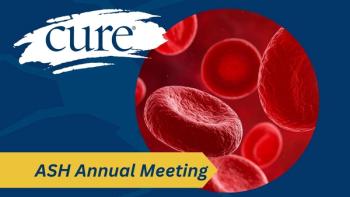
Keeping Calm and Carrying on With CLL
CLL patient shares his experience with the disease and the importance of aiming to live his life to the fullest despite his diagnosis.
Growing up in New York, Pete lived a fairly traditional life. He knew firsthand what it was like to stay the course and make his family happy. He was a good student and son, became an Eagle Scout at 13 and later graduated from an Ivy League university.
“For most people, and definitely for me, we live in a world of fitting in and adapting with the rest of society,” Pete, 81, says. “I did as most kids do, I embraced my family’s values as mine and wanted to be the best little boy in the world and meet the approval of others regardless.”
Pete found himself experiencing a similar feeling of what he terms “keeping calm and carrying on” later in his adulthood when he was diagnosed with chronic lymphocytic leukemia (CLL) — a type of blood cancer - at the age of 69. But this wasn’t the first time he came face to face with a life-altering event.
At 24, he married a woman named Jackie, and they had two children together and were living as a family in Asheville, North Carolina. Pete and Jackie cared deeply about each other and had a wonderful relationship with their kids, yet, they found themselves experiencing issues 13 years into their marriage. Pete needed to reset his course and separated from his wife to embrace a side of him he rarely accepted: Pete came out as a gay man.
“While in the closet, I knew instinctively how to pretend to be straight. It was similar to what my family and I did being Jewish in a very Christian community,” Pete says. “The parallels were clear: you can either be very conspicuous and defiant or you can keep your head down and fit in. I fit in well.” Pete moved to New York City and began to live the life he long dreamt of. Soon after, Pete met and fell in love with his now-husband of 33 years, Wes. “It was a bitter cold night, and I couldn’t get a cab, but knew I could find one outside the Plaza Hotel, where Wes had worked at the time. We literally met as we both went through revolving door,” Pete says. “It was the best door I ever walked through. I got lucky.”
During the time of his CLL diagnosis, Pete had Wes by his side. “It was scary, but I faced it with the love and support from Wes.”
The two were living a life full of travel and activity, making his diagnosis more of a shock because Pete had not experienced any symptoms aside from some fatigue while rock climbing on a trip in Patagonia, Argentina.
“Although the friends I was hiking with in Argentina were younger than me, some of them by a fair amount, I had always been able to keep up with them pretty well,” Pete says. “I hadn't felt the fatigue while hiking, but when we were climbing, I seemed to get out of breath much more readily than I had previously and more than I expected. In retrospect, I realized that was a warning sign, a symptom. It was an ‘aha’ moment.”
Following his trip to Argentina, Pete went to see his doctor for a routine checkup and was told to see a hematologist oncologist after his blood work showed his white blood cell count was high. He was ultimately diagnosed with CLL.
CLL is one of the most common forms of leukemia in adults in the U.S.1 It’s characterized as a slow-growing blood cancer that most commonly arises from B cells, a type of white blood cell that originates in the bone marrow.2 For some people in early stages of the disease, CLL is asymptomatic; however, if the disease progresses, signs and symptoms may include night sweats, swollen lymph nodes, weight loss, fatigue, weakness, among others.3
After receiving the diagnosis from his oncologist, Pete was told he could expect to live about 11 more years with CLL based on his individual health and age, and that he should “watch and wait,” which is an approach sometimes used in slow-growing cancers when a patient and the health care team opt for no treatment but rather actively monitor the disease. Pete and his doctor agreed he would only start treatment when symptoms started.
“It felt a bit strange to not be immediately proactive,” Pete said. But Pete continued on watch and wait for several years as his CLL presented no symptoms. Still, he conducted his own research to learn more about his disease to be fully informed of all of his options if his CLL were to progress.
Nine years after his diagnosis, Pete began to see a CLL specialist when his white blood cell count increased, and his platelet count decreased. His doctor recommended
Pete and his doctor discussed the potential benefits and side effects of IMBRUVICA®, including some of the serious side effects that could occur while on treatment, such as bleeding, infections and heart rhythm problems, as well as some of the common side effects including diarrhea, tiredness, muscle and bone pain, rash, decrease of certain blood cell counts, nausea and bruising.
Scroll down or click here to view the entire Side Effect Information and Uses
“I feel very fortunate with the success I’ve had with IMBRUVICA®,” Pete says. “At first, I experienced stomach issues, but those symptoms subsided. My doctor says I’m doing very well, and I’m happy to report that my doctor says I'm doing quite well.” However, responses may differ for other patients.
Pete believes in the value of leaning on others and coming together to share experiences and help other people who may be going through a similar journey. About three years ago, Pete founded a local chapter for the CLL Society in San Francisco, where he and Wes now live.
“A number of people who are attracted to our support group are newly diagnosed, so generally what I've said to them is, ‘Stay positive, you can work with your healthcare team to discuss an appropriate treatment plan for you. There are encouraging options available that may work for you.’” Pete says. “Of course, every case is different, and we certainly acknowledge that, but on the other hand, people shouldn’t assume the worst. It's also an opportunity to share and to pick other people's brains and to learn from their own experience and their own research.”
When Pete recently celebrated his 80th birthday, he surpassed the 11 years his doctor once estimated he had left to live. “For some people, turning 80 might be a bit of a bummer, but for me it felt like an accomplishment,” he says. “It felt like I achieved a milestone or gotten over a hurdle.” Pete still sees his doctor for regular check-ups to continue to manage his disease.
Looking ahead, Pete would like to travel to Japan and Ireland with Wes. He also plans to continue his hobbies of going on walks and hiking.
“I consider myself to be pretty lucky,” Pete says. “Just continue to educate yourself, work closely with your healthcare team and aim to live life to the fullest.”
While this is Pete’s own experience with CLL, it is important to understand that each journey with this disease is different and patients should work closely with their healthcare teams to determine an appropriate plan for managing their CLL.
What is IMBRUVICA® (ibrutinib)?
IMBRUVICA® (ibrutinib) is a prescription medicine used to treat adults with:
- Chronic lymphocytic leukemia (CLL)/Small lymphocytic lymphoma (SLL)
- Chronic lymphocytic leukemia (CLL)/Small lymphocytic lymphoma (SLL) with 17p deletion
It is not known if IMBRUVICA® is safe and effective in children.
IMPORTANT SIDE EFFECT INFORMATION
Before taking IMBRUVICA®, tell your healthcare provider about all of your medical conditions, including if you:
- have had recent surgery or plan to have surgery. Your healthcare provider may stop IMBRUVICA® for any planned medical, surgical, or dental procedure.
- have bleeding problems.
- have or had heart rhythm problems, smoke, or have a medical condition that increases your risk of heart disease, such as high blood pressure, high cholesterol, or diabetes.
- have an infection.
- have liver problems.
- are pregnant or plan to become pregnant. IMBRUVICA® can harm your unborn baby. If you are able to become pregnant, your healthcare provider will do a pregnancy test before starting treatment with IMBRUVICA®. Tell your healthcare provider if you are pregnant or think you may be pregnant during treatment with IMBRUVICA®.
- Females who are able to become pregnant should use effective birth control (contraception) during treatment with IMBRUVICA® and for 1 month after the last dose.
- Males with female partners who are able to become pregnant should use effective birth control, such as condoms, during treatment with IMBRUVICA® and for 1 month after the last dose.
- are breastfeeding or plan to breastfeed. Do not breastfeed during treatment with IMBRUVICA® and for 1 week after the last dose.
Tell your healthcare provider about all the medicines you take, including prescription and over-the-counter medicines, vitamins, and herbal supplements. Taking IMBRUVICA® with certain other medicines may affect how IMBRUVICA® works and can cause side effects.
How should I take IMBRUVICA®?
- Take IMBRUVICA® exactly as your healthcare provider tells you to take it.
- Take IMBRUVICA® 1 time a day.
- Swallow IMBRUVICA® capsules or tablets whole with a glass of water.
- Do not open, break or chew IMBRUVICA® capsules.
- Do not cut, crush or chew IMBRUVICA® tablets.
- Take IMBRUVICA® at about the same time each day.
- If you miss a dose of IMBRUVICA® take it as soon as you remember on the same day. Take your next dose of IMBRUVICA® at your regular time on the next day. Do not take extra doses of IMBRUVICA® to make up for a missed dose.
- If you take too much IMBRUVICA® call your healthcare provider or go to the nearest hospital emergency room right away.
What should I avoid while taking IMBRUVICA®?
- You should not drink grapefruit juice, eat grapefruit, or eat Seville oranges (often used in marmalades) during treatment with IMBRUVICA®. These products may increase the amount of IMBRUVICA® in your blood.
What are the possible side effects of IMBRUVICA®?
IMBRUVICA® may cause serious side effects, including:
- Bleeding problems (hemorrhage) are common during treatment with IMBRUVICA®, and can also be serious and may lead to death. Your risk of bleeding may increase if you are also taking a blood thinner medicine. Tell your healthcare provider if you have any signs of bleeding, including: blood in your stools or black stools (looks like tar), pink or brown urine, unexpected bleeding, or bleeding that is severe or that you cannot control, vomit blood or vomit looks like coffee grounds, cough up blood or blood clots, increased bruising, dizziness, weakness, confusion, change in your speech, or a headache that lasts a long time or severe headache.
- Infections can happen during treatment with IMBRUVICA®. These infections can be serious and may lead to death. Tell your healthcare provider right away if you have fever, chills, weakness, confusion, or other signs or symptoms of an infection during treatment with IMBRUVICA®.
- Decrease in blood cell counts. Decreased blood counts (white blood cells, platelets, and red blood cells) are common with IMBRUVICA®, but can also be severe. Your healthcare provider should do monthly blood tests to check your blood counts.
- Heart rhythm problems (ventricular arrhythmias, atrial fibrillation and atrial flutter). Serious heart rhythm problems and death have happened in people treated with IMBRUVICA®, especially in people who have an increased risk for heart disease, have an infection, or who have had heart rhythm problems in the past. Tell your healthcare provider if you get any symptoms of heart rhythm problems, such as feeling as if your heart is beating fast and irregular, lightheadedness, dizziness, shortness of breath, chest discomfort, or you faint. If you develop any of these symptoms, your healthcare provider may do a test to check your heart (ECG) and may change your IMBRUVICA® dose.
- High blood pressure (hypertension). New or worsening high blood pressure has happened in people treated with IMBRUVICA®. Your healthcare provider may start you on blood pressure medicine or change current medicines to treat your blood pressure.
- Second primary cancers. New cancers have happened during treatment with IMBRUVICA®, including cancers of the skin or other organs.
- Tumor lysis syndrome (TLS). TLS is caused by the fast breakdown of cancer cells. TLS can cause kidney failure and the need for dialysis treatment, abnormal heart rhythm, seizure, and sometimes death. Your healthcare provider may do blood tests to check you for TLS.
The most common side effects of IMBRUVICA® in adults with B-cell malignancies (MCL, CLL/SLL, WM and MZL) include:
- diarrhea
- tiredness
- muscle and bone pain
- rash
- bruising
The most common side effects of IMBRUVICA® in adults with cGVHD include:
- tiredness
- bruising
- diarrhea
- mouth sores (stomatitis)
- muscle spasms
- nausea
- pneumonia
Diarrhea is a common side effect in people who take IMBRUVICA®. Drink plenty of fluids during treatment with IMBRUVICA® to help reduce your risk of losing too much fluid (dehydration) due to diarrhea. Tell your healthcare provider if you have diarrhea that does not go away.
These are not all the possible side effects of IMBRUVICA®. Call your doctor for medical advice about side effects. You may report side effects to FDA at 1-800-FDA-1088.
General information about the safe and effective use of IMBRUVICA®
Medicines are sometimes prescribed for purposes other than those listed in a Patient Information leaflet. Do not use IMBRUVICA® for a condition for which it was not prescribed. Do not give IMBRUVICA® to other people, even if they have the same symptoms that you have. It may harm them. You can ask your pharmacist or healthcare provider for information about IMBRUVICA® that is written for health professionals.
Please
This story is sponsored by Pharmacyclics and Janssen.
Pete is part of the IMBRUVICA® Ambassador program, a Pharmacyclics, an AbbVie Company, and Janssen Oncology program comprised of patients and caregivers who share their experience regarding their personal disease journey and treatment with IMBRUIVCA®.
[I]Moffitt Cancer Center. September is Blood Cancer Awareness Month – What You Need to Know. Accessed August 2020.
[II] Shaffer ALL, Rosenwald A, Staudt LM. Lymphoid malignancies: the dark side of B-cell differentiation. Nat Rev Immunol. 2002;2(12):920-932.
[III]American Cancer Society. Detailed guide: what is chronic lymphocytic leukemia. Accessed August 2020.
PRC-06933 08/20





